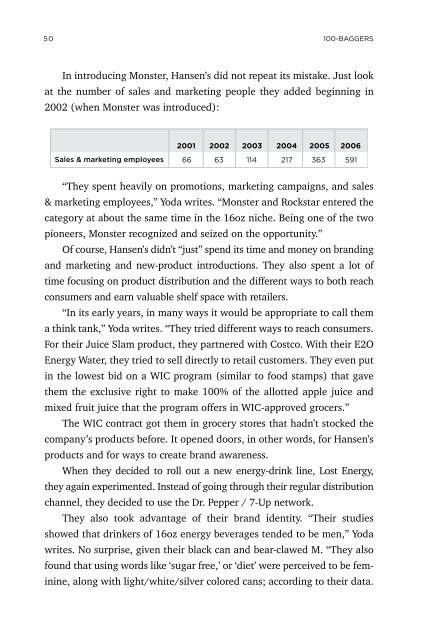You also want an ePaper? Increase the reach of your titles
YUMPU automatically turns print PDFs into web optimized ePapers that Google loves.
50<br />
100-BAGGERS<br />
In introducing Monster, Hansen’s did not repeat its mistake. Just look<br />
at the number of sales and marketing people they added beginning in<br />
2002 (when Monster was introduced):<br />
Sales & marketing employees<br />
2001 2002 2003 2004 2005 2006<br />
66 63 114 217 363 591<br />
“They spent heavily on promotions, marketing campaigns, and sales<br />
& marketing employees,” Yoda writes. “Monster and Rockstar entered the<br />
category at about the same time in the 16oz niche. Being one of the two<br />
pioneers, Monster recognized and seized on the opportunity.”<br />
Of course, Hansen’s didn’t “just” spend its time and money on branding<br />
and marketing and new-product introductions. They also spent a lot of<br />
time focusing on product distribution and the different ways to both reach<br />
consumers and earn valuable shelf space with retailers.<br />
“In its early years, in many ways it would be appropriate to call them<br />
a think tank,” Yoda writes. “They tried different ways to reach consumers.<br />
For their Juice Slam product, they partnered with Costco. With their E2O<br />
Energy Water, they tried to sell directly to retail customers. They even put<br />
in the lowest bid on a WIC program (similar to food stamps) that gave<br />
them the exclusive right to make 100% of the allotted apple juice and<br />
mixed fruit juice that the program offers in WIC-approved grocers.”<br />
The WIC contract got them in grocery stores that hadn’t stocked the<br />
company’s products before. It opened doors, in other words, for Hansen’s<br />
products and for ways to create brand awareness.<br />
When they decided to roll out a new energy-drink line, Lost Energy,<br />
they again experimented. Instead of going through their regular distribution<br />
channel, they decided to use the Dr. Pepper / 7-Up network.<br />
They also took advantage of their brand identity. “Their studies<br />
showed that drinkers of 16oz energy beverages tended to be men,” Yoda<br />
writes. No surprise, given their black can and bear-clawed M. “They also<br />
found that using words like ‘sugar free,’ or ‘diet’ were perceived to be feminine,<br />
along with light/white/silver colored cans; according to their data.


